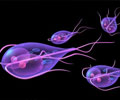Hemolytic Uremic Syndrome of Shigellosis
Hemolytic Uremic Syndrome (HUS) is an unusual complication associated with E.coli related gastro-enteritis, it is also rarely seen with bacillary dysentery.
Hemolytic Uremic Syndrome (HUS) is an uncommon complication of shigellosis (type I species). It can become a life-threatening problem due to kidney failure. It tends to affect more children and elderly people. In children HUS occurs after several days of bloody diarrhea.
The usual cause of HUS is due to certain strain O157:H7 of the bacteria Escherichia coli (E. coli) that causes digestive tract infection and also bloody diarrhea like shigella infection. Shigella is close cousin of E.coli and can also precipitate HUS.
Adults also may develop hemolytic uremic syndrome after an E. coli infection, but more often the cause is obscure or even unknown.
In this syndrome the child suffers from an anemia due to hemolysis (breakdown) of blood cells, hence the name hemolytic. It is also accompanied by kidney failure or uremia.
If kidney failure sets in the child's urine output diminishes and urine may become red due to bleeding within the urinary tract.
The child appears pale and irritable and unexplained small red patches appear on the body with bleeding from nose and mouth. Once kidney failure sets in there is swelling of the limbs and body and blood pressure rises due to the inability of the kidney to excrete water and toxic wastes of the body.
Treatment usually requires checking and maintaining the salt and water levels in the body. If the hemoglobin drops due to anemia – blood transfusion is required. However severe cases with kidney failure may need a few sessions of hemodialysis for stabilization. Most children recover but in some cases there may be permanent damage to the kidneys. This means there is a need for long term dialysis or a transplant .











